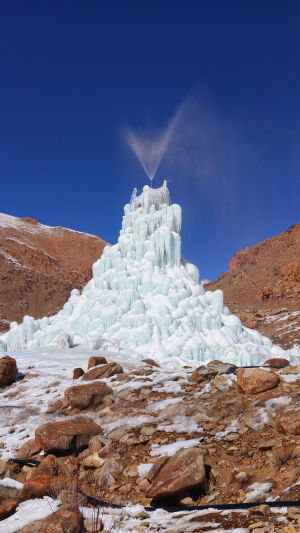Ladakh, a region in northern India, is known for its stunning landscapes and unique culture. But beyond its beauty, Ladakh faces a significant challenge: water scarcity. With limited rainfall and a harsh climate, finding enough water for agriculture and daily use can be tough.
Enter the Ice Stupas, an innovative solution designed to address this issue. Dear Lykkers! Let’s dive into what Ice Stupas are and how they are making a difference in Ladakh.
<h3> What Are Ice Stupas?</h3>
Ice Stupas are large, cone-shaped structures made of ice. These ice stupas are created by directing water from mountain streams into a central location where it is allowed to freeze. The result is a massive mound of ice that gradually melts over time, providing a steady supply of water during the dry months.
<h3> How Are Ice Stupas Made?</h3>
Creating an Ice Stupa involves a few key steps:
<b>1.Water Collection:</b> Water from melting glaciers or mountain streams is collected and redirected into a designated area.
<b>2.Ice Formation:</b> The collected water is released in a controlled manner onto a central structure, typically a large, cone-shaped frame. This water freezes quickly, forming a large mound of ice.
<b>3.Maintenance:</b> The Ice Stupa needs regular maintenance to ensure it retains its shape and size. Snow and ice might be added to the structure to help it last longer.
<h3> Benefits of Ice Stupas </h3>
Ice Stupas offer several benefits:
• <b> Water Supply:</b> They provide a reliable water source during the winter and early spring months when other sources might be scarce.
• <b> Agricultural Boost:</b> Farmers in Ladakh can use the water from Ice Stupas to irrigate their fields, which helps improve crop yields.
• <b> Innovation and Tradition:</b> The Ice Stupa project blends modern engineering with traditional knowledge and practices, creating a sustainable solution that respects local culture.
<h3> The Impact on Ladakh </h3>
The Ice Stupa initiative has had a positive impact on Ladakh in various ways:
• <b> Enhanced Water Security:</b> By providing an alternative water source, Ice Stupas help ensure that communities have enough water for their needs throughout the year.
• <b> Economic Growth:</b> Better irrigation leads to improved agricultural productivity, which can boost the local economy.
• <b> Community Involvement:</b> The creation and maintenance of Ice Stupas often involve local communities, fostering a sense of ownership and cooperation.
<h3> Challenges and Future Prospects </h3>
Despite their success, Ice Stupas do face some challenges. They require careful planning and maintenance, and their effectiveness can be influenced by climate conditions. However, with ongoing research and development, there is hope that the concept will continue to evolve and provide even greater benefits in the future.
Ice Stupas are a remarkable example of how innovative thinking can address complex problems. By turning water into ice and storing it for later use, this ingenious solution helps Ladakh tackle its water scarcity issues. As climate change continues to impact regions around the world, the Ice Stupa model offers valuable lessons in sustainability and adaptation.
How the ice stupas of Ladakh bring water to the Himalayan desert | DW News
Video by DW News





